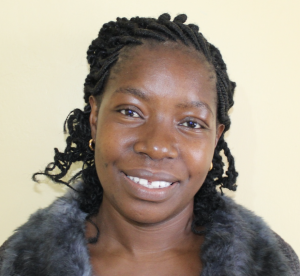Shivakala Health Center was established in 2020 and provides essential medical services to the surrounding communities of Shamoni, Ifwetere, Lunyinya, and Ematiha. Before this facility was established, people used to walk long distances to seek medical attention. The center's seven staff members regularly care for 60 patients a day, but without safe, sufficient water, that task is nearly impossible, even though it is critical to the community's well-being.
The center's staff currently rely on water collected in a small rainwater tank, but it inevitably runs dry because the water it holds is very quickly depleted. When it does, they are forced to leave the facility grounds to collect water from an unprotected community spring.

The center's staff.
It is an exhausting task that, at minimum, takes an hour but even longer during the rainy season when the paths are muddy and dangerous. Worst of all, they are literally collecting water that will most likely degrade people's health even further, but without an alternative, they have no choice. They need water to operate and survive.

Collecting water from the local unprotected spring.
"As a nurse at Shivakala Dispensary, I am deeply concerned about the quality of our drinking water. Both current water sources are contaminated, posing a significant risk to everyone, including staff, patients, and our families. It is heartbreaking to see patients suffer from diseases that could be prevented by [the] availability of clean water. When we (healthcare workers) get sick, our work is affected, which compromises the quality of care that we offer," shared 32-year-old nurse Phanice Keya.

Nurse Keya in front of the center's small rain tank.
Frequent waterborne illnesses among community members, including the clinic staff, from consuming contaminated water strain personal finances and the center's resources. It also steals everyone's health and ability to make a livelihood. It is a vicious cycle that will not end until clean water is available.

"Clean water is a basic necessity, and it is truly unfortunate that we are still struggling with this issue of contaminated water. Water is a valuable commodity which significantly improves our health outcomes and overall well-being. It allows us to focus on providing the best care possible to our community. It is crucial that we invest in a reliable water source, but we cannot afford to install one at the moment," Nurse Keya continued.

Nurse Keya serves patients.
Field Officer Christine Masinde shared about the center's future plans. "The management of the health facility has plans of setting up a maternity wing to cater for expectant mothers, if they get funding [for] the project. This new waterpoint will provide water for construction if their plan goes through. It will also enhance maternal and neonatal health by ensuring a clean and hygienic environment, and improve patient care by supporting necessary medical procedures and reducing infection risks."
Water is critical to the proper operation of any healthcare facility.

"While speaking with the nursing staff, I could feel her deep concern for [the] health and well-being of her patients and other staff, including herself. She described how lack of clean water affects everything from basic hygiene to sterilization of medical equipment and tools, making it clear how critical this issue is to their daily operations and the quality of care they can provide. Her dedication to work despite these challenges highlighted the urgent need for a reliable source," Ms. Masinde continued.
"Drilling a well for this healthcare facility will provide a more reliable, safe, and sustainable water source, unlike the current inadequate and contaminated sources," Ms. Masinde concluded.
Steps Toward a Solution
Our technical experts worked with the local community to identify the most effective solution to their water crisis. They decided to drill a borehole well, construct a platform for the well, and attach a hand pump.
Well
Abundant water often lies just beneath our feet. Aquifers—natural underground rivers—flow through layers of sediment and rock, offering a constant supply of safe water. A borehole well is drilled deep into the earth to access this naturally filtered and protected water. We penetrate meters, sometimes even hundreds of meters, of soil, silt, rock, and more to reach the water underground. Once found, we construct a platform for the well and attach a hand pump. The community gains a safe, enclosed water source capable of providing approximately five gallons of water per minute. Learn more here!
Handwashing Stations
Alongside each water source, we install handwashing stations at points of care and at the latrines, enabling everyone at the health center to wash their hands. Handwashing is crucial for preventing water-related illnesses within the health center and community. Health center staff will maintain the stations, fill them with water, and supply them with soap, which we will teach them how to make.
Latrines
We ensure there are Ventilated Improved Pit (VIP) latrine blocks that effectively prevent the transmission of fecal diseases. Each latrine will boast a durable cement floor for easy use and maintenance. We’ll ensure at least one stall is reserved for staff, along with gender-separated toilets that include menstrual hygiene facilities and accessible options for individuals with limited mobility.
Health Center Education & Ownership
Hygiene and sanitation training are integral to our water projects. Training is tailored to each health center's specific needs and includes key topics such as proper water handling, improved hygiene practices, disease transmission prevention, and care of the new water point. Encouraged and supported by the guidance of our team, a water user committee comprises a community health volunteer, the staff in charge of the clinic, a community leader, and the health center board representative. They assume responsibility for maintaining the waterpoint, promoting safe hygiene and sanitation practices, and keeping handwashing stations well-stocked.
Safe water and improved hygiene habits foster a healthier future for everyone in the community.

 Borehole Well and Hand Pump
Borehole Well and Hand Pump
 Rehabilitation Project
Rehabilitation Project































